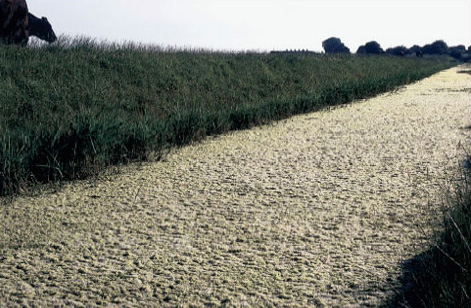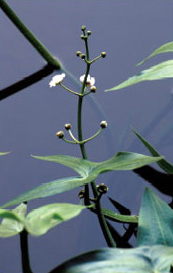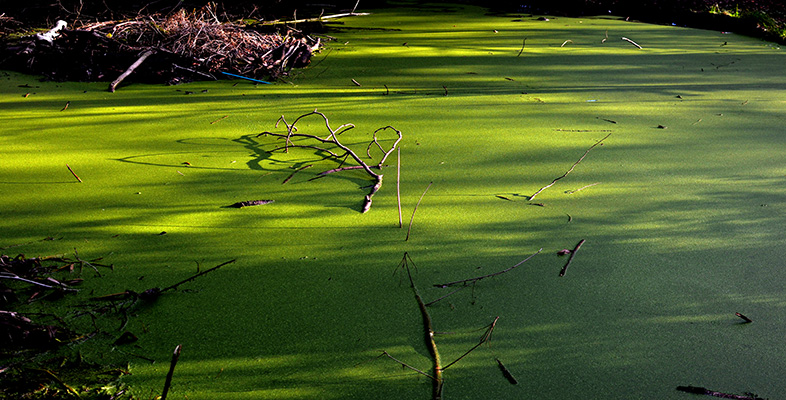2.1 Effects on primary producers in freshwater ecosystems
Plant species differ in their ability to compete as nutrient availability increases. Some floating and submerged macrophyte species are restricted to nutrient-poor waters, while others are typical of nutrient-rich sites (see Table 2.2). Figure 2.2 shows turbid water in a polluted drainage ditch associated with localized growth of algae. There are no aquatic plants present.
| Trophic state | Associated macrophytespecies |
|---|---|
| oligotrophic | alternate water-milfoil (Myriophyllum alternifolium) bog pondweed (Potamogeton polygonifolius) |
| oligo-mesotrophic | bladderwort (Utricularia vulgaris) |
| eutrophic | hairlike pondweed (Potamogeton trichoides) |
| tending towards hypertrophic | spiked water-milfoil (Myriophyllum spicatum) fennel-leaved pondweed (Potamogeton pectinatus) |

In rivers, the presence of plant species such as the yellow water-lily (Nuphar lutea) and the arrowhead (Sagittaria sagittifolia, Figure 2.3) are likely to indicate eutrophic conditions. In some rivers, the fennel-leaved pondweed (Potamogeton pectinatus) is tolerant of both sewage and industrial pollution.

Whereas some species can occur in waters with quite a wide range of nutrient levels, some are relatively obligate to specific trophic bands and are unable to survive if nutrient levels alter significantly from those to which they are adapted. In 1989, Michael Jeffries derived ranges of tolerance for a number of macrophyte species by studying literature on their occurrence and distribution in relation to different aspects of water quality. He also reviewed results of scientific studies reported in the literature to determine what concentrations of nitrate, ammonia, phosphorus, suspended solids and biological oxygen demand (BOD) appeared to be associated with severe or total loss of macrophyte species due to eutrophication (see Table 2.3). Research has suggested that changes to certain macrophyte communities can occur at soluble reactive phosphorus concentrations as low as 20 μg 1(1(0.02 mg l(1). Soluble reactive phosphorus (SRP) is the term commonly used to describe phosphorus that is readily available for uptake by organisms. It is used in contrast to measures of total phosphorus, which include forms of the element that are bound to sediment particles or locked up in large organic molecules. These forms are unavailable for immediate uptake, but they may become available over time.
Question 2.1
Water samples from two lowland rivers, A and B, are found to contain the following concentrations of plant nutrients.
| Nutrient | Concentration/mg l-1 | |
|---|---|---|
| River A | River B | |
| nitrate | 2.2 | 12.1 |
| ammonia | 0.07 | 0.6 |
| SRP | 0.18 | 0.13 |
By reference to Table 2.3, what conclusions can you draw about the probable diversity of aquatic macrophytes in each of the rivers?
| Condition | SRP/mg P l−1 | Nitrate/mg N l−1 | Ammonia/mg N l−1 | Suspended solids | BOD |
|---|---|---|---|---|---|
| ‘natural’ | |||||
| degraded (partial loss of species found under ‘natural’ conditions) | 0.1-0.2 | 3.0-10 | 0.2-5.0 | 30-100 | 2.0-6.0 |
| severe loss of species | >0.2 | >10 | >5.0 | >100 | >6.0 |
Footnotes
BOD, biological oxygen demand; SRP, soluble reactive phosphorus.
Answer
River A has a soluble reactive phosphorus concentration in the range 0.1-0.2 mg 1−1, which corresponds to the ‘degraded’ category in Table 2.3. This suggests that the diversity of macrophytes would be less than in the pristine natural state, due to a limited eutrophication effect. Neither form of nitrogen is present at concentrations above the natural range, so primary productivity may become limited by nitrogen rather than phosphorus, limiting the impact of the elevated phosphorus concentration.
River B has a similar concentration of SRP to river A, which would again place it in the ‘degraded’ category, but a much higher concentration of nitrogen in both its forms, especially nitrate at 12.1 mg 1−1, taking it into the ‘severe loss of species’ category. The elevated availability of both P and N would boost primary production in the watercourse, favouring algal communities and leading to a decline in macrophyte populations and diversity. The more competitive macrophytes may benefit from the increased nutrient availability, but their increased growth would further exclude less competitive species, resulting in lower diversity.
